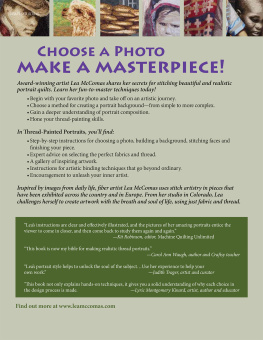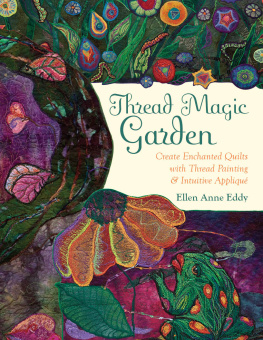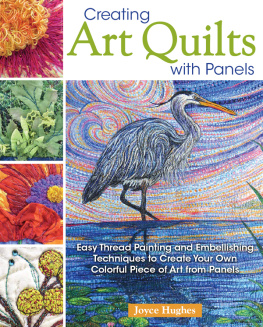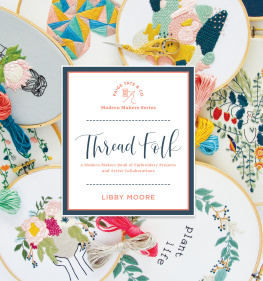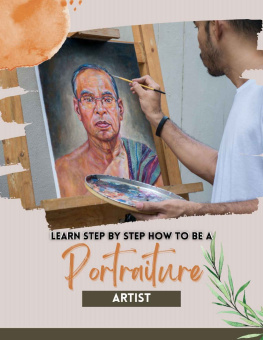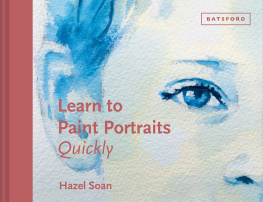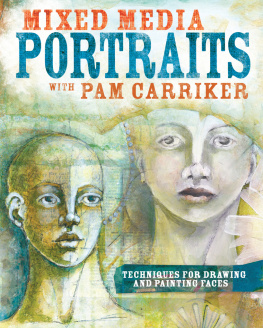Copyright 2014 Lea McComas
ALL RIGHTS RESERVED
No part of this book may be reproduced in any manner without the express written consent of the author except in the case of brief excerpts in critical reviews and articles. All inquiries should be addressed to the contact information listed on this
website: www.leamccomas.com
Print ISBN: 978-0-9907802-0-5
eBook ISBN 978-0-9907802-1-2
McComas Fiber Art
3515 Castle Peak Ave.
Superior, Colorado 80027
Contributors:
Developmental Editor: Janice Brewster, www.creativegirlfriendspress.com
Cover & Book Designer: Karen Sulmonetti, www.sulmonettidesign.com
Process Photography: Lea McComas
Art Quilt Photography: Ken Sanville
Photograph of Giorgio and Valentina: Floriano Gambalonga, www.flogastudio.com
Photograph Mining Prospecting scan # 10025763, and Denver- Recreation- Bicycles scan # F-6015,
Courtesy of History Colorado, Denver, Colorado
Photograph: Native American Women, # 2007.17.418, Courtesy of The History Museum, Great Falls, Montana
Product photos courtesy of GrabARoo's, Supreme Slider and Mistyfuse (See Resources for contact information.)
To my husband, and fellow artist, Jim McComas. You are my mentor, my muse and the love of my life.
THREAD-PAINTED
PORTRAITS
INTRODUCTION
W hat is a thread-painted portrait? Ive seen the term thread painting applied to a number of different artistic fiber representations from a simple outline of a form, to moderate stitching that adds texture and implies shape, to dense stitching that covers the surface and defines shape, texture and provides intricate detail. The latter is more my style and the technique I address in this book.
I share my home studio with my husband, a classically trained artist. His style is contemporary realism, and the inspiration for my technique. With the simple medium of fabric and thread, I seek to create a similar aesthetic. In this book, I show step-by-step procedures for thread painting the various features of the face in great detail, but always keep in mind that this intense level of detail may not be appropriate for your composition. Just as in painting a portrait, the level of detail varies with the scale and scope of the portrait. I work from the belief that one can always have too much knowledge, disregard what is not useful, and find success.

Why do I make thread-painted portraits? Ive been quilting since I was a teen and have explored numerous techniques as a traditional quilter and as a fiber artist. I love to explore and develop new skills. It wasnt until my husband began a course of classical training as an artist at a local atelier that I became intrigued with representational works of art. I started with landscape and still life compositions.
Then, one day, I met with another fiber artist and expressed my desire to make portrait quilts. The response was an emphatic, You dont want to do that. Faces are too difficult. In that moment, I knew where my artist path would lead. I accepted as my personal challenge that I would create portrait quilts using only fabric and thread. I get a thrill out of seeing an image emerge from the fabric surface and I find huge satisfaction in applying just the right stitches to make my images realistic and lively.
I think it is a natural desire to want to capture and share images of those special people in our lives or the faces that exemplify some aspect of the human condition. For those of us with an addiction to fabric, what could be better than combining the two? Today, we have tools and technology that put this process in reach for any sewist who is willing to give it a try.
This book offers instruction and tips for both simple and complex images. There is something for the beginner and the advanced thread painter. As with anything, the best results come after much practice. I hope you will explore my techniques and, above all, have fun learning.
Best Friends
8 by 9 inches
EQUIPMENT AND SUPPLIES
T hread-painted portraits are created on a background of fabric pieces fused to a base fabric or on an inspiration photo printed onto fabric. The type of background you choose will affect some of the supplies youll need.
SEWING MACHINE
A thread-painted portrait quilt can be made on almost any sewing machine, but as with most things in life, quality matters. For this process, high-end features are not required, but a solid machine in good working order is. The machine should allow you to disengage, or drop, . If you are uncertain if your machine has this feature, or are not sure how to access it, check your operating manual, or talk with a local sewing machine dealer or repair person.
To free-motion stitch on your machine, first disengage the feed dogs so you can sew in any direction.
You will need a looks like your written signature, then you have achieved a good amount of control and are ready to move on.
A free-motion, or darning, foot allows you to see your stitching. The spring gives the foot a hopping action.
Challenge yourself to learn to free-motion stitch your signature.
Practice stitching on quilt sandwiches from scrap fabric and batting.
Dont worry about your stitch-length setting. With the feed dogs disengaged, it will be up to you to move the quilt. The stitch length will be determined by the combination of the speed at which the needle moves up and down, and the speed at which you move the quilt. Again, practice free-motion stitching on your small until you are comfortable with the process and find the speed combination that works best for you.
If youre working on a longarm machine, I strongly recommend that you not employ a stitch regulator for this process. You will stop and change directions often while stitching, which will cause the motor to rev up and slow down. There will also be a slight delay in the machines response to your actions, putting extra stress on your machine. I learned this hard truth from experience when I threw off the timing on my longarm just as I was scrambling to meet a deadline. My machine went to the hospital and I missed the deadline. I also find that the changing sound of the motor while using the stitch regulator causes me to tense up. It is important to remain relaxed while stitching, so I turn off the regulator and turn up the music.

